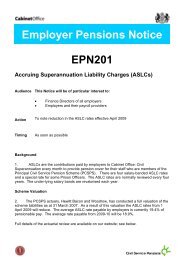Capability Reviews: Progress and Next Steps - The Civil Service
Capability Reviews: Progress and Next Steps - The Civil Service
Capability Reviews: Progress and Next Steps - The Civil Service
- No tags were found...
You also want an ePaper? Increase the reach of your titles
YUMPU automatically turns print PDFs into web optimized ePapers that Google loves.
Case study: Effective performance management by the board in DCSF‘DCSF, like its predecessor DfES, oversees a large-scale <strong>and</strong> complex deliverynetwork. DfES was one of the smallest departments but with responsibility forsignificant spend on the Government’s challenging agenda for children, families<strong>and</strong> young people. On top of DfES running costs <strong>and</strong> resources it had 18 NDPBsemploying 10,000 staff with annual running costs in excess of £500m. DCSFinherits much of this complex organisation <strong>and</strong> now has additional responsibilityacross government to achieve challenging outcomes for children. It is thereforeimportant that it has clear objectives <strong>and</strong> sophisticated management of itsdelivery chain linked to clear roles, responsibilities <strong>and</strong> accountabilities. Effectiveleadership by the DCSF board requires clear performance information <strong>and</strong> arelentless focus on delivery.Development of quarterly corporate performance reporting has enabled the DCSFboard to develop its capacity <strong>and</strong> willingness to challenge performance againstobjectives <strong>and</strong> PSAs, strengthening accountability across the department.Non-executive board members provide external challenge when the DCSF boardconsiders corporate performance, <strong>and</strong> they have been involved in a series ofchallenge panels focused on the likelihood of delivering PSAs. Delivery partners,including NDPBs, also have the opportunity to discuss performance issues forthe delivery chain as a whole through the DCSF Group (see the related casestudy on the DCSF Group on page 54), <strong>and</strong> their work is being aligned with thenew performance framework.Scrutiny of departmental risks is given by the Risk Committee, which includesall directors general <strong>and</strong> is chaired by the Director General Corporate <strong>Service</strong>s.<strong>The</strong> Committee evaluates the most severe risks to DCSF in terms of delivery,operation <strong>and</strong> reputation. <strong>The</strong>se are currently reported every quarter by thedepartment’s Permanent Secretary to the Secretary of State for Children, Schools<strong>and</strong> Families. This system of risk management is subject to additional scrutiny bythe department’s Audit <strong>and</strong> Risk Assurance Committee, which is chaired by one ofthe board’s non-executives <strong>and</strong> which has a majority of independent externalmembers, including the National Audit Office.Through the new system of improved quarterly reporting of progress against thedepartment’s new objectives <strong>and</strong> targets, the DCSF board will monitor theperformance of the overall schools <strong>and</strong> children’s system, the department <strong>and</strong>NDPBs. <strong>The</strong> department’s newly formed ‘corporate bridge’ enables staff in thedepartment to access <strong>and</strong> engage with information on the delivery of betteroutcomes for children, young people <strong>and</strong> families.’• <strong>The</strong> executive team is collectively assessed for a bonus against the achievementof corporate objectives <strong>and</strong> collaborative teamwork; there is positive feedbackabout a ‘more cohesive … more corporate <strong>and</strong> more effective board’ (DWP).28COMMON CAPABILITY GAPS: PROGRESS AND NEXT STEPS
















